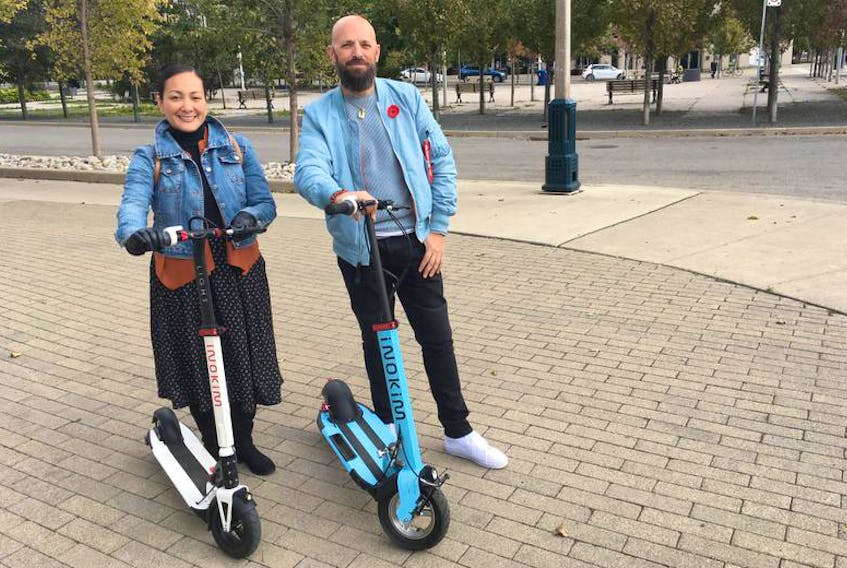TORONTO — People often hear it before they see it, a dissonant eeeeeee noise from down the road.
Then they turn and see me, an adult man standing upright and still like a mannequin, smiling like a buffoon on this skateboard-with-a-handle, scooting toward them at 20 km/h.
It’s slow enough we have ample time to make eye contact. They: bewildered. Me: trying not to laugh.
This scene played out frequently during my two weeks as an e-scooter-er, or e-scooterist, or member of the e-scooterati. This technology is so new we don’t yet have the vocabulary to talk about it.
“E-scooter” refers to all sorts of electric e-things: bicycles, mopeds, motorbikes, hover boards, Segways, gyroscopic-single-wheel-mirco-mobility-doodads, as well as the vehicle currently under review.
This particular machine is the $1,699 Inokim Quick 3 Hero. It’s sometimes referred to as a kick-scooter or a push-scooter. If you were young in ’00s, you would recognize it as similar to a Razor scooter, a toy kids rode to school or around the playground.
It’s the same kind of e-scooter currently popping up in cities from San Francisco to Hamilton thanks to scooter-share companies like Lime and Bird.
Diana Pissarouk and Phil Panetta discovered e-scooters while touring around San Diego on them.
“You can have (an e-scooter) as your primary mode of transportation, especially if you’re urban, or if not, it’s supplemental,” Pissarouk says. Since they got theirs, both she and Panetta say they’ve been driving significantly less.
Pissarouk and Panetta live in Mississauga and Oakville respectively. They enjoyed their first scootering experience so much that last summer they opened an online shop, Electric Avenue, which loaned me the Quick 3 for this story.
“My son is in Grade 11,” Pissarouk says. “He was taking it to high-school and putting it in his locker ... The feedback was insanity. The first week he used it, he was like, ‘mom I got completely swamped by students and facilty.’”
Electric Avenue sells a range of e-scooters from Inokim, an Israeli-designed, Chinese-manufactured brand. Prices range from $990 to $2,600. There are three-wheeled models, some with seats and others that you can wheel behind you like a suitcase when not riding.
Ford and Audi both developed e-scooter concepts as a solution to the Last Mile problem of getting into and out of congested downtown cores.
Recently, Ford purchased Spin, an e-scooter sharing start-up, for around US$40 million. General Motors recently announced an e-bike of its own and is asking the public to name it. There’s a $10,000 prize for the winning idea.
My first metres of e-scootering were wobbly. It was a trial by fire, teetering all the way up from Toronto’s Lakeshore Drive to Dundas Street. Soon, however, I was trying to pop wheelies; e-scooters are extremely easy to ride.
The Quick 3’s lithium-ion battery, placed under the board between the wheels, gives a manufacturer-estimated range of 27-30 kilometres on a single charge, which is about right, if a tad optimistic for colder months.
A full charge takes five hours on a household outlet. Top speed is 25 km/h; I may have hit that once or twice, but certainly not uphill. On steep slopes it struggled, but always made it to the top, eventually.
The thumb-throttle has an initial delay, but then the scooter takes off. If you’re not standing on it, it will wheelie itself into the air. Acceleration isn’t so blazing you need to hang on tight, but it’s quicker than your average commuter on a bicycle.
Leaning side to side, the scooter makes smooth sweeping turns. I can’t surf, but I imagine it feels something like this; it’s ridiculously fun.
Panetta keeps a scooter in the back of his car. One day, he was stuck in traffic, late to meet Pissarouk in Toronto. “I parked at Fort York and in seven minutes I was up at Young-Dundas Square. I think I got back to my car and back onto Lakeshore before she’d got her car out of the underground parking at Young-Dundas,” he says.
It is a quick way to get around a city, but awkward once you get to your destination. At a restaurant, I requested a table with space to accommodate the large scooter. Everyone looked as I tried and failed to be cool lugging this 14.5-kilogram machine between the tables.
Locking the scooter to bike posts is possible, but inelegant. Bike theft being what it is in Toronto, I wouldn’t want to leave this flashy-looking $2,000 machine locked up outside for long.
Comments from friends who tried the scooter ranged from: “fun but too lame to consider buying until some critical threshold of my peers do,” to “it would be good post-apocalypse,” to “it’s a skateboard for people who can’t balance.” After a test-ride, one of them who initially hated it said, “I take it back; I love it.” Everyone who tried it had the same involuntary goofy grin.
There has been an explosion of e-things, all of which promise to disrupt, enhance, or otherwise revolutionize mobility. Regulations are lagging behind, leaving many in a legal grey area.
A representative from the City of Toronto’s Cycling Infrastructure and Programs Unit wrote to Pissarouk and Panetta saying, “since your electric push scooter can be operated with muscle power you are permitted to ride it in cycle tracks and multi-use trails.”
In Hamilton, Lime’s shared e-scooters aren’t allowed on streets. The rules vary by municipality, so check with yours before you start popping e-scooter wheelies down Main Street.
Kick-scooters are not the future of transportation, but they could be one part of a larger network of micro-mobility e-things that — hopefully — reduce pollution and time wasted in traffic. At this point, anything is worth a try.









